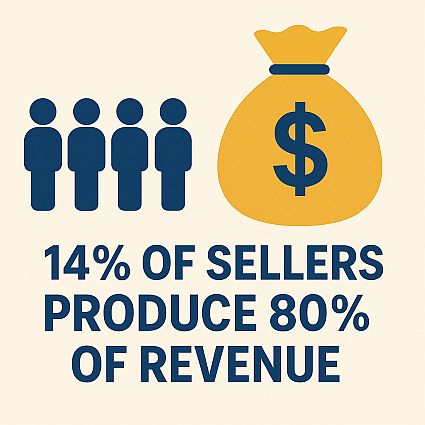“14% of sellers drive 80% of revenue!” This, and similar data points, are showing up in my feeds, with various experts commenting on what it means, then offering insights and solutions to address.
While I have a lot of questions about this data and would like to get under the numbers to better understand, I’m always amused by the insights and recommendations provided by the experts. It seems this data point has become an inviolable law of nature. It’s there with other “laws of nature,” things like: The sun always rises in the east and sets in the west, what goes up must come down, one sock always disappears in the laundry. We know these to be inviolable and arrange our lives around them.
In selling, we seem to have similar laws of nature. Things like “win rates are 15-20%,” “35-38% of your people will make goal,” “tenure is 11-18 months,” “the key to success is retention/renewal, don’t waste your time on new customer acquisition.” This is yet one more distinguished addition to the selling laws of nature.
The experts are offering their solutions, “Give all the best leads and deals to the 14% to maximize your growth!” Or “Great expansion of your sales force is too risky and too costly, 86% of them will fail!”
My mind is a little weird. I start playing out some of these scenarios.
What if we redirected all our best leads and deals to the top 14%?
Well, that means we are purposefully designing our organizations to fail Sending the best opportunities to our top 14% will widen the gap. They will increase their success, drive more revenue. And we ship our mediocre or bad opportunities to our lower performers, wondering why they don’t win them.
Then I play this scenario further a couple of quarters or a year. Now our best performers are overwhelmed, they never were sitting at their desks twiddling their thumbs, but now we keep loading them up with more. Inevitably their win rates decline, their revenue starts to decline. They are overworked and success is declining. They start thinking, “I need to go some place different.” And we risk losing our top 14%.
And the other 86% are struggling, they are getting the worst opportunities, they are increasingly unsuccessful. They start looking for a change, they go someplace else, looking for a new job, a new start.
Then this gets us to the next part of the problem. Backfilling the 14% of high performers, backfilling the 86%.
Someone played the 14% data point on me, when I made a comment somewhere on “dramatically growing the sales force.” The claim was the risk and the expense was too high, we really couldn’t expand! It got me thinking, “Hmmm, what do I do?” I imagined alternative scenarios, perhaps I go to HR saying, “We need to recruit a lot of sellers. 86% of them need to be mediocre, 14% of them need to be high performers! Bring me candidates!”
Then as they bring me candidates, I’m paralyzed! As I look at each candidate, in the back of my mind, “There’s an 86% chance this person is mediocre!”
I’ll stop here, I think you get the point.
I’m constantly astounded by the absence of questioning and critical thinking. Why are so few asking, “What are the 14% doing that makes them so successful? How can I get the 86% to do more of those things? What training, coaching do I need to do to raise their performance?” Or, “What are the characteristics of these top performers, how to I look for these characteristics in my recruiting?”
Or if I was not to do that critical thinking, and was looking for more of a knee jerk reaction, I would tend to do something different than these experts outline. My knee jerk reaction might be, “Why don’t I give the toughest deals to my top performers? They are the people that will have the highest probability of winning those deals. And let me give the good leads/opportunities to others and coach them to help them win more of those deals, then over time, they contribute more, and we might move to a 80/20 split, then a 70/30……”
I’ll stop whining here. But this is what frustrates me so much about what I see happening in a profession I love.
Why do we take these “symptoms” and treat them as inviolable laws of nature and selling?
Why don’t we take the time to ask, “What’s causing this? Why is it happening? What do we change to more effectively achieve our goals? What can we learn from our top performers and how do we leverage that in improving the performance of everyone else?”
We have to stop reacting to symptoms, rather focusing on understanding and addressing problems.
But we don’t do this, so low win rates, low performance, high turnover, lack of engagement become the selling laws of nature and we go on. And we see constant declines in performance.
This is less a seller problem, it’s a leadership problem. It’s a lack of imagination, creativity, curiosity, critical thinking, problem solving. It’s a consequence of fixed mindsets, where we have stopped learning and growing.
We have so much opportunity. There is so much untapped potential in our organizations. As leaders, it’s our jobs to create a culture of constant improvement.
Afterword: Here is the AI generated discussion of this post. The discussion is fascinating, it looks like the algorithms have changed. It’s a little more debate oriented, even pushing back on the positions I’m taking. I really like this new positioning in the discussion. Enjoy!

Leave a Reply